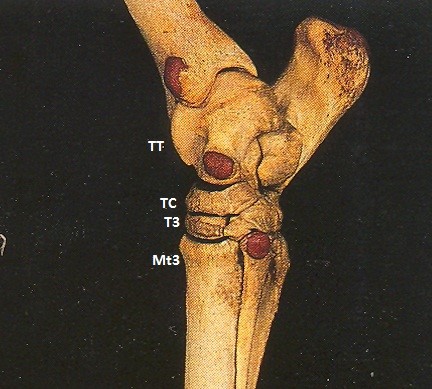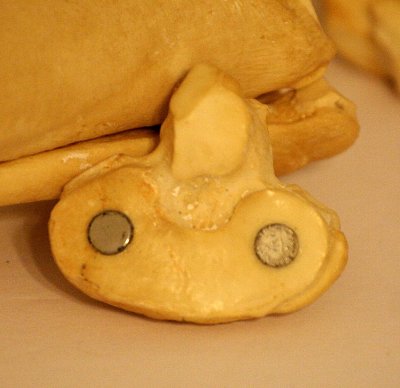Mechnoresponsivenss 17 Simple
Mechano-responsiveness 17
Simple
“In equitation as in politics, one should beware of simplifications; they always complicate the matter at the end.” (General Decarpentry, Academic Equitation, 1949)
Stimulating flexion of the hock or the knee touching the limbs with a whip is simple, but it is a travesty. Simple is a mockery flatting the rider’s ego but complicating the horse task. The shape of the bones, like on this picture, the shape of T3 and its connection with TC, which is the middle join of the hock, clearly shows that the bones of the joints are designed for a very precise synchronization of movements combining flexion, extension and medial to lateral and lateral to medial rotation. When proper correlation between flexion, extension and inward rotations is altered by touching the limb with a whip, or improper coordination between vertebral column and limbs movements, sharing forces occur which, over a period of time, develop arthritis.
From impact to push off, there is a very precise synchronization between flexion extension and inward rotations of the joints designed to absorb impact and storing elastic strain energy that is used for the following sequence of the stride swinging the leg forward. When properly coordinated, the energy stored in the tendons, aponeurosis and muscles during the decelerating phase of the stride is used for the propulsive phase and the swing.  The amplitude of the swing, such as for instance the elevation of the knees during the piaff, is proper use of an elastic strain energy stored in tendons and muscles during the stance. When the horse is improperly coordinated for the move such as for instance, carrying too much weight on the forelegs during the piaff, the elevation of the forearm is poor and trainers who do not understand the dynamics creating a correct piaff, try to create artificial gesture of the forelegs touching the limb with a whip. The mockery further complicates the horse task. The horse has to use muscles instead of tendons to lift the leg in spite of a weight distribution and body coordination that is improper for the legs movements that they are asked to perform. The subtle correlation between flexion, extension and inward rotations of the joints is not only altered but the joints are asked to perform in and angle and timing and duration that is contrary to their design. (The round metal circles are magnets )
The amplitude of the swing, such as for instance the elevation of the knees during the piaff, is proper use of an elastic strain energy stored in tendons and muscles during the stance. When the horse is improperly coordinated for the move such as for instance, carrying too much weight on the forelegs during the piaff, the elevation of the forearm is poor and trainers who do not understand the dynamics creating a correct piaff, try to create artificial gesture of the forelegs touching the limb with a whip. The mockery further complicates the horse task. The horse has to use muscles instead of tendons to lift the leg in spite of a weight distribution and body coordination that is improper for the legs movements that they are asked to perform. The subtle correlation between flexion, extension and inward rotations of the joints is not only altered but the joints are asked to perform in and angle and timing and duration that is contrary to their design. (The round metal circles are magnets )

“Everything should be made as simple as possible but not simpler.” (Albert Einstein) The equine locomotor mechanism is a marvel of precision, efficiency but also complexity. The art of dressage is the ability to properly synchronize this complex and sophisticated mechanism. The art of dressage is not altering such precise mechanism through simpler riding and training techniques. Complexity can be clearly explained but not simplified. Instead, lameness and mediocrity can be simplified since lameness and performances below the horse’s talent results from improper coordination of the horse’s physique for the athletic demand of the performance.
Everyone agree that gaits as well as performances commence with the engagement of the horse hind legs. Proper locomotion demands adequate coordination between the rotation of the hind limb and therefore the femur around the hip joint and dorso-ventral rotation of the pelvis-sacrum unit. When the dorso-ventral rotation of the pelvis is altered by dysfunction of the thoracolumbar spine, the same engagement of the hind limb demands greater rotation of the femur around the hip joint. At the level of the femur/tibia junction, which is the stifle, excessive pendular movement of the femur around the hip joint induces excessive inward rotation lateral to medial that is placing the medial patellar ligament over the ridge of the femoral trochlea. This is the mechanism of upward fixation, or accidental lock of the patella and therefore stifle problem. Dysfunction of the thoracolumbar spine can be created by simpler theories such as relaxation, stretching, that are exactly the opposite of the way the muscular system of the thoracolumbar column effectively functions. In 1976. Hans Carlson demonstrated that beside resisting gravity, the main function of the back muscles was protecting the thoracolumbar spine from an amplitude of movement that would exceed the thoracolumbar spine’s possible range of motion. In fact, since the aim of the science of motion is identifying and correcting the root cause of the problem, we rehabilitate stifle problems recreating proper dorso-ventral rotation of the pelvis and therefore proper function of the thoracolumbar column. This is why, not only the horses regain soundness but they also improve the quality of their trot. In his quantitative study, Mikael Holmström demonstrated that better movers exhibited greater dorso-ventral rotation of the pelvis.
Many simplistic theories are increasing the load on the forelegs, driving seat, heavy weight on the bit, long and low, fast forward, etc. Proponents of these simple approaches minimize the damaging effects of increased load on the forelegs. Simple is a marketing strategy that is conveniently skipping the complexity of the systems and the damages induced on the limbs as well as structures when the systems are not subtly coordinated. Simple theories regard the stance, which is the sequence of the stride where the hoof is on the ground, as a simple support phase. In reality, there is during the stance, a very complex succession of dynamic phenomenon that are altered by excessive load on the forelegs. In the first 20% of the stance, the power flow is acting downward and is absorbed by the flexors of the fetlock joint. The flexors are tendons that are regulated by muscles. Between 20% and 45% of the stance, the power flow is reversed the flexor muscles produce power that is transported upward participating in the lift of the trunk. From 40% to 60%, the power flow is acting downward and is absorbed by the fetlock and coffin joint flexor. The only tendon inserted on the coffin joint is the deep digital flexor tendon and therefore the loading power is absorbed by the deep flexor muscle. From 60% to 90%, The fetlock flexor produce power which is transported upward. The concept of power transport is totally unknown form simple theories but is part of sound locomotion. Muscles covering several joints can take power at one joint and produce power at another joint. Of course the mechanism is complex but it is a marvel of efficiency. This superb mechanism is enhanced by an equitation and an education understanding and respecting the complexity of the equine biomechanics. Instead, this superb mechanism is destroyed by simple training techniques. Jean Luc COrnille 2016



 twitter
twitter facebook
facebook google
google stumbleupon
stumbleupon pinterest
pinterest yahoo
yahoo linkedin
linkedin